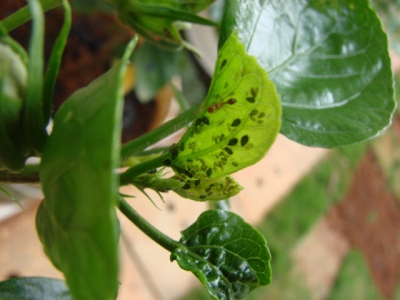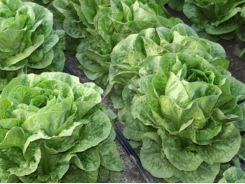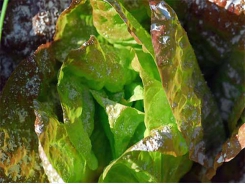Biological control of aphids

The subject of biological control of aphids is a complex one, as different crops require different approaches, and the season plays a role as well.
Bean aphids just starting up. No ladybirds are present as yet.
The fact remains, though – many farmers automatically apply a toxic spray to a crop as soon as an aphid is spotted. And while this might be needed in some cases, in many others it’s not the best approach. Lettuce is a case in point. If lettuce mosaic virus (LMV) is present, then immediate chemical measures are needed. Spread by aphids, this virus can render the whole crop unmarketable if allowed to spread.
Some weeds are also LMV carriers and aphids may ‘transport’ the virus from these weeds outside the land into the lettuce crop. However, if no LMV has been observed for at least some months, you can conclude that this virus isn’t a current hazard and adopt a different approach to control.
Vigilance
Aphids are very common. They can travel quite a distance on air currents, and may continue to invade the land regularly. This means that you have to be constantly vigilant for their presence. It may also mean repeat sprays. And this is where natural enemies play their part.
If aphid numbers are low and labybirds and other biological control agents are present, then it’s simply a matter of regular monitoring. These bugs will deal with any new arrivals, and can clean up the crop completely. This has been noted in New Zealand and the US, where modest aphid infestations on young plants have been left to the beneficial insects.
Spraying
Researchers have found that the insects have been able to deal with infestations before the marketing stage, whereas other sections had to be repeatedly sprayed. This system is even more successful with successive plantings. A problem arises when you have to spray for other pests, such as caterpillars. Try to choose a product which will kill the caterpillars without harming the beneficial insects. And these are more effective when the pests are at a very young stage and still on the exposed leaves.
As soon as either the caterpillars or aphids get into the developing head, control becomes a lot more difficult. This is why integrated pest management (IPM) requires a hands-on approach. At least with aphids, beneficial insects are able to enter areas of the plant that are difficult to reach with sprays.
Organic
Green beans experience sporadic outbreaks of black aphids. Infection usually starts off as easy-to-spot patches in the land on a few plants alongside one another. Once again, you need to see how many beneficial insects are present before taking action. A high ladybird population will quickly take care of the problem. If there are only a few, or none (seldom the case), you can consider spot spraying. One worker with a knapsack can walk up and down the rows and spray only the infected areas with Pirimicarb.
The ladybirds will ‘hunt’ aphids in other areas and attack any colonies which may have been too small to spot. At this point they’ll usually be able to take care of the situation without further intervention by you. This same approach can be used for cabbages, where you often find single plants infested with aphids, but with an array of predators. As it occurs mostly in winter, the aphid is operating at its ‘optimum climatic adaptability’, whereas the beneficial insects slow down. Spot spray infected areas and the beneficial insects will move elsewhere and clean up the pest.
I’ve had considerable success with this method on a large scale, often avoiding having to do overall sprays altogether. The trick is to spray infected plants before the cabbage aphids reach the winged stage. Organic growers will have to be very careful in choosing the correct insecticide. Many products are environmentally safe and non-toxic, but the mechanisms which make them effective may also be lethal to the beneficial insects.
Related news
Tools

Phối trộn thức ăn chăn nuôi

Pha dung dịch thủy canh

Định mức cho tôm ăn

Phối trộn phân bón NPK

Xác định tỷ lệ tôm sống

Chuyển đổi đơn vị phân bón

Xác định công suất sục khí

Chuyển đổi đơn vị tôm

Tính diện tích nhà kính

Tính thể tích ao




 How to Grow a Small-Space Vegetable Garden
How to Grow a Small-Space Vegetable Garden  Brassica Vegetables And How to Grow Them Successfully
Brassica Vegetables And How to Grow Them Successfully